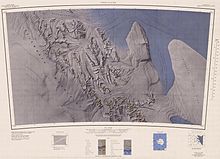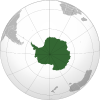
Transport in Antarctica has transformed from explorers crossing the isolated remote area of Antarctica by foot to a more open era due to human technologies enabling more convenient and faster transport, predominantly by air and water, but also by land as well. Transportation technologies on a remote area like Antarctica need to be able to deal with extremely low temperatures and continuous winds to ensure the travelers' safety. Due to the fragility of the Antarctic environment, only a limited amount of transport movements can take place and sustainable transportation technologies have to be used to reduce the ecological footprint. The infrastructure of land, water and air transport needs to be safe and sustainable. Currently thousands of tourists and hundreds of scientists a year depend on the Antarctic transportation system.

McMurdo Station is an American Antarctic research station on the southern tip of Ross Island. It is operated by the United States through the United States Antarctic Program (USAP), a branch of the National Science Foundation. The station is the largest community in Antarctica, capable of supporting up to 1,500 residents, though the population fluctuates seasonally; during the antarctic night, there are as few as a few hundred people. It serves as one of three year-round United States Antarctic science facilities. Personnel and cargo going to or coming from Amundsen–Scott South Pole Station usually first pass through McMurdo, either by flight or by the McMurdo to South Pole Traverse; it is a hub for activities and science projects in Antarctica. McMurdo, Amundsen-Scott, and Palmer are the three United States stations on the continent, though by the Antarctic Treaty System the bases are not a legal claim ; they are dedicated to scientific research. New Zealand's Scott Base is nearby on Hut Peninsula and across the channel is a helicopter refueling station at Marble Point. The bases are served by airfields and a port, though access can be limited by weather conditions which can make it too hard to land aircraft, and an icebreaker may be needed to reach the port facility.

Vinson Massif is a large mountain massif in Antarctica that is 21 km (13 mi) long and 13 km (8 mi) wide and lies within the Sentinel Range of the Ellsworth Mountains. It overlooks the Ronne Ice Shelf near the base of the Antarctic Peninsula. The massif is located about 1,200 kilometres (750 mi) from the South Pole. Vinson Massif was discovered in January 1958 by U.S. Navy aircraft. In 1961, the Vinson Massif was named by the Advisory Committee on Antarctic Names (US-ACAN), after Carl G. Vinson, United States congressman from the state of Georgia, for his support for Antarctic exploration. On November 1, 2006, US-ACAN declared Mount Vinson and Vinson Massif to be separate entities. Vinson Massif lies within the unrecognised Chilean claim under the Antarctic Treaty System.

Dakshin Gangotri was the first scientific base station of India situated in Antarctica, part of the Indian Antarctic Programme. It is located at a distance of 2,500 kilometres (1,600 mi) from the South Pole. It is currently being used as a supply base and transit camp. The base is named after Dakshin Gangotri Glacier.

The Ellsworth Mountains are the highest mountain ranges in Antarctica, forming a 350 km (217 mi) long and 48 km (30 mi) wide chain of mountains in a north to south configuration on the western margin of the Ronne Ice Shelf in Marie Byrd Land. They are bisected by Minnesota Glacier to form the Sentinel Range to the north and the Heritage Range to the south. The former is by far the higher and more spectacular with Mount Vinson constituting the highest point on the continent. The mountains are located within the Chilean Antarctic territorial claim but outside of the Argentinian and British ones.

Lincoln Ellsworth was an American polar explorer, engineer, surveyor, and author. He led the first Arctic and Antarctic air crossings.
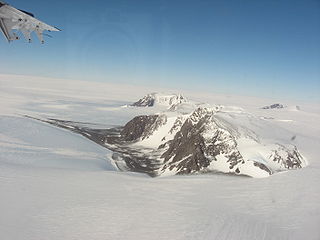
The Thiel Mountains are isolated, mainly snow-capped mountains of the Transantarctic Mountains System, located in the Ellsworth Land region of Antarctica. The mountain range is 45 nautical miles long, is located roughly between the Horlick Mountains and the Pensacola Mountains, and extends from Moulton Escarpment on the west to Nolan Pillar on the east. Major components include Ford Massif, Bermel Escarpment and a group of eastern peaks near Nolan Pillar.

The United States Antarctic Program is an organization of the United States government which has a presence in the Antarctica continent. Founded in 1959, the USAP manages all U.S. scientific research and related logistics in Antarctica as well as aboard ships in the Southern Ocean.
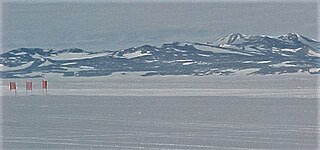
A blue ice runway is a runway constructed in Antarctic areas with no net annual snow accumulation. The density of the ice increases as air bubbles are forced out, strengthening the resultant ice surface so that aircraft landings using wheels instead of skis can be supported. Such runways simplify the transfer of materials to research stations, since wheeled aircraft can carry much heavier loads than ski-equipped aircraft.

Blue ice occurs when snow falls on a glacier, is compressed, and becomes part of the glacier. During compression, air bubbles are squeezed out, so ice crystals enlarge. This enlargement is responsible for the ice's blue colour.

Troll Airfield is an airstrip located 6.8 kilometres (4.2 mi) from the research station Troll in Princess Martha Coast in Queen Maud Land, Antarctica. Owned and operated by the Norwegian Polar Institute, it consists of a 3,300-by-100-metre runway on glacial blue ice on the Antarctic ice sheet. The airport is located at 1,232 metres (4,042 ft) above mean sea level and is 235 kilometres (146 mi) from the coast.
The British Antarctic Survey (BAS) is the United Kingdom's national polar research institute. It has a dual purpose, to conduct polar science, enabling better understanding of global issues, and to provide an active presence in the Antarctic on behalf of the UK. It is part of the Natural Environment Research Council (NERC). With over 400 staff, BAS takes an active role in Antarctic affairs, operating five research stations, one ship and five aircraft in both polar regions, as well as addressing key global and regional issues. This involves joint research projects with over 40 UK universities and more than 120 national and international collaborations.

Patriot Hills Base Camp was a private seasonally occupied camp in Antarctica. It was located in the Heritage Range of the Ellsworth Mountains, next to the Patriot Hills that gave it its name.
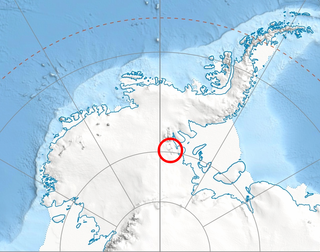
Union Glacier, is a large, heavily crevassed glacier which receives the flow of several tributaries and drains through the middle of the Heritage Range, Ellsworth Mountains, Antarctica. The glacier drains from the plateau at Edson Hills on the west side of the range and flows east between Pioneer Heights and Enterprise Hills. Union Glacier was mapped by U.S. Geological Survey (USGS) from surveys and U.S. Navy (USN) air photos, 1961–66. The name was applied by Advisory Committee on Antarctic Names (US-ACAN) in association with the name Heritage Range.

Union Glacier Blue-Ice Runway is the blue ice runway for Union Glacier Camp in Antarctica. It is located in the Heritage Range, Ellsworth Mountains, on the glacier that gives it its name. It is operated by Antarctic Logistics & Expeditions LLC (ALE), a company that provides expedition support and tours to the interior of Antarctica.

Patriot Hills is a line of rock hills 5 nautical miles (9 km) long, located 3 nautical miles (6 km) east of the north end of Independence Hills in Horseshoe Valley, Heritage Range, Western Antarctica.
Teniente Arturo Parodi Alister Base was a Chilean Antarctic research base located in the claimed Chilean Antarctic Territory. It was inaugurated on December 7, 1999, and was located about 1 km from the Patriot Hills Base Camp, operated by the American private company Adventure Network International, together with a blue ice aerodrome. After the transfer to the Union glacier of the operations of the company in November 2010, the base was disarmed and transferred to the Union glacier at the end of 2013. It operated from November to December every two years by the Air Force of Chile with a population of 25 people, but could provide life support to 40 people.
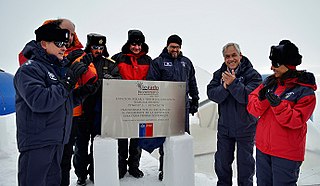
The Estación Polar Científica Conjunta Glaciar Unión or Union Glacier Station is a summer Antarctic base of Chile, situated on Union Glacier in the Ellsworth Mountains. It is jointly operated from November to January by the Chilean Antarctic Institute and the three armed forces of Chile. It was inaugurated on 4 January 2014 by Chilean President Sebastián Piñera Echeñique.


